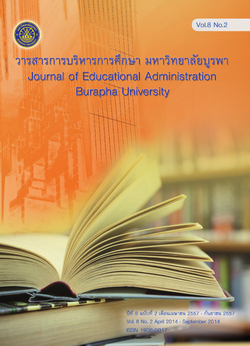แนวทางการบริหารจัดการเชิงกลยุทธ์ด้านความรับผิดชอบต่อสังคมของมหาวิทยาลัยบูรพา : กรณีศึกษาคณะพยาบาลศาสตร์ (Guideline for Strategic Management in University Social Responsibility of Burapha University: A Case Study of Nursing Faculty)
Keywords:
การบริหารจัดการเชิงกลยุทธ์, ความรับผิดชอบต่อสังคม, คณะพยาบาลศาสตร์ มหาวิทยาลัยบูรพา, Strategic Management, Social Responsibility, Nursing Faculty Burapha UniversityAbstract
บทคัดย่อ
การวิจัยครั้งนี้มีวัตถุประสงค์เพื่อพัฒนาและประเมินผลการทดลองใช้แนวทางการบริหารจัดการเชิงกลยุทธ์ด้านความรับผิดชอบต่อสังคมของมหาวิทยาลัยบูรพา: กรณีศึกษาคณะพยาบาลศาสตร์โดยใช้รูปแบบการวิจัยแบบผสมผสาน (Mixed methodology) ดำเนินการวิจัย 3 ขั้นตอน คือ ขั้นตอนที่ 1 การศึกษาข้อมูลและการสัมภาษณ์ผู้บริหารมหาวิทยาลัยในกำกับของรัฐที่ออกนอกระบบ 7 แห่ง ได้แก่ มหาวิทยาลัยบูรพา จุฬาลงกรณ์มหาวิทยาลัย มหาวิทยาลัยทักษิณ มหาวิทยาลัยเชียงใหม่ สถาบันเทคโนโลยีพระจอมเกล้าเจ้าคุณทหารลาดกระบังมหาวิทยาลัยมหิดล และมหาวิทยาลัยเทคโนโลยีพระจอมเกล้าพระนครเหนือ รวมทั้งสิ้น 7 คน ขั้นตอนที่ 2 การพัฒนาแนวทางการบริหารจัดการเชิงกลยุทธ์ด้านความรับผิดชอบต่อสังคมของมหาวิทยาลัยบูรพา ฉบับร่างและการสัมภาษณ์ความคิดเห็นของกลุ่ม ผู้เชี่ยวชาญจำนวน 17 ท่าน ขั้นตอนที่ 3 เป็นการทดลองใช้แนวทางที่คณะพยาบาลศาสตร์ มหาวิทยาลัยบูรพา และประเมินผลโดยการสอบถามและการสัมภาษณ์ผู้ใช้ จากประชากร 139 คนโดยการสุ่มอย่างง่ายได้กลุ่มตัวอย่าง 103 คน รวมทั้งการสอบถามหัวหน้าโครงการและคณะผู้รับผิดชอบโครงการบริการวิชาการด้านความรับผิดชอบต่อสังคม 2 โครงการ จำนวน 19 คน เครื่องมือที่ใช้ในการวิจัย ได้แก่ แบบบันทึกผลสัมฤทธิ์ของโครงการและแบบสอบถามความพึงพอใจของผู้ทดลองใช้แนวทางเพื่อประเมินผล โดยมีผู้ทรงคุณวุฒิเป็นผู้ตรวจสอบคุณภาพและความเที่ยงตรงของเครื่องมือ จำนวน 5 ท่าน สถิติที่ใช้การวิเคราะห์ข้อมูลเชิงคุณภาพ คือ การวิเคราะห์เนื้อหา ข้อมูลเชิงปริมาณ คือ ค่าความถี่ ร้อยละ ค่าเฉลี่ย ส่วนเบี่ยงเบนมาตรฐาน และเปรียบเทียบความแตกต่างโดยการทดสอบค่าที (t-test) ผลการวิจัย พบว่า
1. แนวทางการบริหารจัดการเชิงกลยุทธ์ด้านความรับผิดชอบต่อสังคมของมหาวิทยาลัยบูรพามีองค์ประกอบที่สำคัญตามตัวแบบเชิงระบบ (System Model) ดังนี้
1.1 ปัจจัยนำเข้า ประกอบด้วยทิศทางของมหาวิทยาลัย กฎหมาย ระเบียบ ข้อบังคับหลักเกณฑ์ต่าง ๆ และผู้มีส่วนได้ส่วนเสีย
1.2 กระบวนการ ประกอบด้วย 4 ขั้นตอน คือ 1) การวินิจฉัยองค์กรเชิงกลยุทธ์ 2) การกำหนดนโยบายของมหาวิทยาลัยด้านความรับผิดชอบต่อสังคม 3) การกำหนดวัตถุประสงค์และพันธะสัญญา 3 ด้าน คือ สังคมเศรษฐกิจและสิ่งแวดล้อม และ 4) การวางแผนและการนำไปสู่การปฏิบัติ
1.3 ผลลัพธ์ เป็นการประเมินตนเองตามตัวชี้วัดที่ได้มีการตกลงเป็นพันธะสัญญาไว้
1.4 ปัจจัยย้อนกลับเป็นการนำข้อมูลที่ได้จากการประเมินตนเองและรายงานสู่การพัฒนาคุณภาพ 2 แบบ คือ 1) การพัฒนาคุณภาพอย่างต่อเนื่อง และ 2) การยกระดับคุณภาพการดำเนินงาน
2. ผลการทดลองใช้ผู้ทดลองใช้มีความคิดเห็นว่าแนวทางการบริหารจัดการเชิงกลยุทธ์ด้านความรับผิดชอบต่อสังคม มีคุณค่า มีประโยชน์ มีความเป็นไปได้ มีความถูกต้องและเหมาะสมโดยรวมอยู่ในระดับมากที่สุด ส่วนการปฏิบัติจริงโดยรวมอยู่ในระดับมาก เปรียบเทียบระหว่างความมีคุณค่า มีประโยชน์ มีความเป็นไปได้ 3 มีความถูกต้องและเหมาะสมกับระดับการปฏิบัติจริง แล้วพบว่า มีความแตกต่างกันอย่างมีนัยสำคัญทางสถิติที่ระดับ .01 การประเมินผลลัพธ์จากตัวชี้วัดของโครงการ 2 โครงการ มีความสำเร็จและบรรลุตามเป้าหมาย ร้อยละ 100 ผู้ทดลองใช้มีความพึงพอใจโดยรวมอยู่ในระดับมาก แนวทางการบริหารจัดการเชิงกลยุทธ์ด้านความรับผิดชอบต่อสังคมของมหาวิทยาลัยบูรพา ควรมีการกำหนดเป็นนโยบายและนำมาใช้เพื่อสร้างความตระหนักและพัฒนาความร่วมมือกับสังคม ชุมชนทั้งภายในและภายนอกมหาวิทยาลัยในการพัฒนาสังคม เศรษฐกิจ และสิ่งแวดล้อมให้เกิดความยั่งยืนต่อไป
ABSTRACT
The purposes of this study were 1) to develop guideline for strategic management in university social responsibility of Burapha University. 2) To evaluate a trial of this guideline in the Faculty of Nursing, Burapha University. The university social responsibility’s strategic management guideline was developed by conducting in three steps namely; 1) Content analysis by studying evolution of CSR and investigating university social responsibility guideline in Thailand and interviewing the autonomous university administrators based on their opinion and experience in USR and setting strategies for establishing university social responsibility guideline. 2) Criticism of the guideline by 17 experts to investigate strategic university social responsibility guideline in Burapha University, and 3) the evaluation USR guideline by 2 dimensions. At first, comparing between value, usefulness, feasibility, accuracy and appropriation of USR guideline and the real practice in the Faculty of Nursing, Burapha University. The sample consisted of 103 administrators and staffs of the Faculty of Nursing, Burapha University from 139 populations. Second, evaluating achievement of 2 academic service projects were used USR guideline by using the projects indicators and asking them about satisfaction of USR guideline testing in the head and staffs of these projects. The sample consisted of 19 USR guideline users. The questionnaires were tested for validity by 5 experts. Alpha Cronbach reliability coefficients were .7592 and .7139 respectively. Statistical methods used for data analysis included content analysis, frequency, percentage, mean, standard deviation and t-test.
The results were as follows:
1. The components of the strategic USR guideline in Burapha University follows by system model consisted of:
1.1 The input of strategic analysis were philosophy/vision/ mission of this university, laws and regulations and stake-holder’s needs,
1.2 The four processes namely; 1) strategic diagnosis by using were SWOT Analysis, 2) policy of university social responsibility setting, 3) the objectives 3 commitments; social, economic and environment, and, 4) implementation in mission of university.
1.3 The results were achievement evaluated by using projects indicators in 2 academic service projects that used USR guideline.
1.4 Feedback was concerned from the report for continuous improvement and enhancing the commitments by using strategic gap and creating value added.
2. The opinion of users in the Faculty of Nursing was in the most level. It means the USR guideline was useful, feasible, appropriate and accurate. The practical operation in Faculty of Nursing was in high level. The comparison of mean differences were statistically significant at .01. The achievements of two projects in academic services were in 100 percentages and the users’ satisfaction was in high level.
This study was recommended that guideline of strategic USR in Burapha University: A case study of Faculty of Nursing ought to use as a tool for organizational and system development and collaborate with communities for sustainable developing social, economic and environment.


